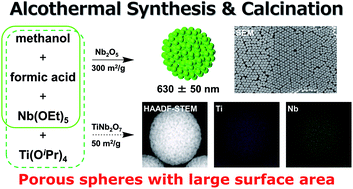Porous niobia spheres with large surface area: alcothermal synthesis and controlling of their composition and phase transition behaviour†
Abstract
Submicron-sized niobia (Nb2O5) porous spheres with a high specific surface area (300 m2 g−1) and nano concave–convex surfaces were synthesized via a rapid one-pot single-step alcothermal reaction. Prolonged reaction time or high reaction temperatures resulted in a morphology change of Nb2O5 from amorphous sphere to rod crystals with hexagonal crystal phase. A similar alcothermal reaction yielded TiO2–Nb2O5 composite porous spheres, whose Ti : Nb molar ratio was controlled by changing the precursor solution component ratios. A simple thermal treatment of amorphous TiO2–Nb2O5 porous spheres consisting of 1 : 2 (molar ratio) Ti : Nb at 600 °C for 2 h induced crystal phase transfer from amorphous to a monoclinic crystal phase of submicron-sized TiNb2O7 porous spheres with a specific surface area of 50 m2 g−1.



 Please wait while we load your content...
Please wait while we load your content...